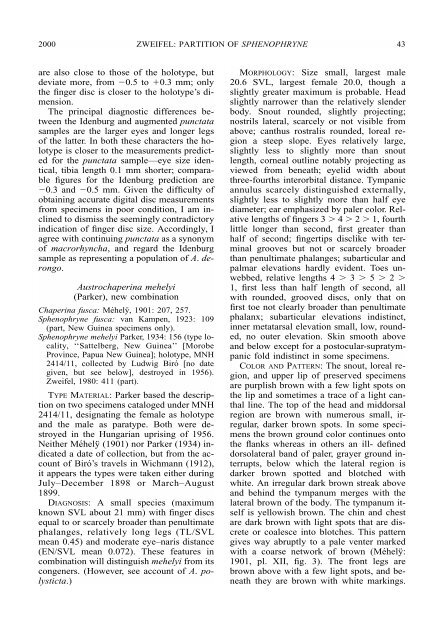SPHENOPHRYNE - American Museum of Natural History
SPHENOPHRYNE - American Museum of Natural History
SPHENOPHRYNE - American Museum of Natural History
Create successful ePaper yourself
Turn your PDF publications into a flip-book with our unique Google optimized e-Paper software.
2000 ZWEIFEL: PARTITION OF <strong>SPHENOPHRYNE</strong><br />
43<br />
are also close to those <strong>of</strong> the holotype, but<br />
deviate more, from 0.5 to 0.3 mm; only<br />
the finger disc is closer to the holotype’s dimension.<br />
The principal diagnostic differences between<br />
the Idenburg and augmented punctata<br />
samples are the larger eyes and longer legs<br />
<strong>of</strong> the latter. In both these characters the holotype<br />
is closer to the measurements predicted<br />
for the punctata sample—eye size identical,<br />
tibia length 0.1 mm shorter; comparable<br />
figures for the Idenburg prediction are<br />
0.3 and 0.5 mm. Given the difficulty <strong>of</strong><br />
obtaining accurate digital disc measurements<br />
from specimens in poor condition, I am inclined<br />
to dismiss the seemingly contradictory<br />
indication <strong>of</strong> finger disc size. Accordingly, I<br />
agree with continuing punctata as a synonym<br />
<strong>of</strong> macrorhyncha, and regard the Idenburg<br />
sample as representing a population <strong>of</strong> A. derongo.<br />
Austrochaperina mehelyi<br />
(Parker), new combination<br />
Chaperina fusca: Méhely¨, 1901: 207, 257.<br />
Sphenophryne fusca: van Kampen, 1923: 109<br />
(part, New Guinea specimens only).<br />
Sphenophryne mehelyi Parker, 1934: 156 (type locality,<br />
‘‘Sattelberg, New Guinea’’ [Morobe<br />
Province, Papua New Guinea]; holotype, MNH<br />
2414/11, collected by Ludwig Biró [no date<br />
given, but see below], destroyed in 1956).<br />
Zweifel, 1980: 411 (part).<br />
TYPE MATERIAL: Parker based the description<br />
on two specimens cataloged under MNH<br />
2414/11, designating the female as holotype<br />
and the male as paratype. Both were destroyed<br />
in the Hungarian uprising <strong>of</strong> 1956.<br />
Neither Méhely¨ (1901) nor Parker (1934) indicated<br />
a date <strong>of</strong> collection, but from the account<br />
<strong>of</strong> Biró’s travels in Wichmann (1912),<br />
it appears the types were taken either during<br />
July–December 1898 or March–August<br />
1899.<br />
DIAGNOSIS: A small species (maximum<br />
known SVL about 21 mm) with finger discs<br />
equal to or scarcely broader than penultimate<br />
phalanges, relatively long legs (TL/SVL<br />
mean 0.45) and moderate eye–naris distance<br />
(EN/SVL mean 0.072). These features in<br />
combination will distinguish mehelyi from its<br />
congeners. (However, see account <strong>of</strong> A. polysticta.)<br />
MORPHOLOGY: Size small, largest male<br />
20.6 SVL, largest female 20.0, though a<br />
slightly greater maximum is probable. Head<br />
slightly narrower than the relatively slender<br />
body. Snout rounded, slightly projecting;<br />
nostrils lateral, scarcely or not visible from<br />
above; canthus rostralis rounded, loreal region<br />
a steep slope. Eyes relatively large,<br />
slightly less to slightly more than snout<br />
length, corneal outline notably projecting as<br />
viewed from beneath; eyelid width about<br />
three-fourths interorbital distance. Tympanic<br />
annulus scarcely distinguished externally,<br />
slightly less to slightly more than half eye<br />
diameter; ear emphasized by paler color. Relative<br />
lengths <strong>of</strong> fingers 3 4 2 1, fourth<br />
little longer than second, first greater than<br />
half <strong>of</strong> second; fingertips disclike with terminal<br />
grooves but not or scarcely broader<br />
than penultimate phalanges; subarticular and<br />
palmar elevations hardly evident. Toes unwebbed,<br />
relative lengths 4 3 5 2 <br />
1, first less than half length <strong>of</strong> second, all<br />
with rounded, grooved discs, only that on<br />
first toe not clearly broader than penultimate<br />
phalanx; subarticular elevations indistinct,<br />
inner metatarsal elevation small, low, rounded,<br />
no outer elevation. Skin smooth above<br />
and below except for a postocular-supratympanic<br />
fold indistinct in some specimens.<br />
COLOR AND PATTERN: The snout, loreal region,<br />
and upper lip <strong>of</strong> preserved specimens<br />
are purplish brown with a few light spots on<br />
the lip and sometimes a trace <strong>of</strong> a light canthal<br />
line. The top <strong>of</strong> the head and middorsal<br />
region are brown with numerous small, irregular,<br />
darker brown spots. In some specimens<br />
the brown ground color continues onto<br />
the flanks whereas in others an ill- defined<br />
dorsolateral band <strong>of</strong> paler, grayer ground interrupts,<br />
below which the lateral region is<br />
darker brown spotted and blotched with<br />
white. An irregular dark brown streak above<br />
and behind the tympanum merges with the<br />
lateral brown <strong>of</strong> the body. The tympanum itself<br />
is yellowish brown. The chin and chest<br />
are dark brown with light spots that are discrete<br />
or coalesce into blotches. This pattern<br />
gives way abruptly to a pale venter marked<br />
with a coarse network <strong>of</strong> brown (Méhely¨:<br />
1901, pl. XII, fig. 3). The front legs are<br />
brown above with a few light spots, and beneath<br />
they are brown with white markings.
















